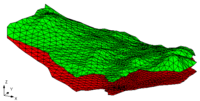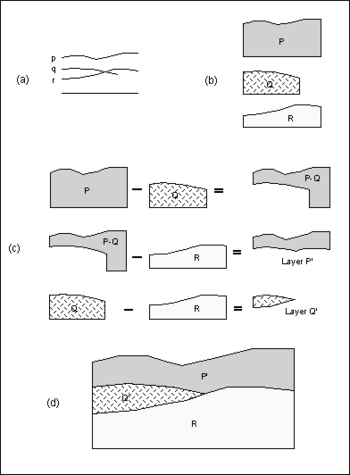GMS:Building Solids and 3D Meshes with TINs: Difference between revisions
From XMS Wiki
Jump to navigationJump to search
No edit summary |
No edit summary |
||
| (2 intermediate revisions by the same user not shown) | |||
| Line 1: | Line 1: | ||
{{TIN links}} | {{TIN links}} | ||
TINs can be used to build 3D solid models as well as 3D meshes. This can be done by selecting the following commands in the | TINs can be used to build 3D solid models as well as 3D meshes. This can be done by selecting the following commands in the ''TINs'' menu: | ||
; [[GMS:Horizons to Solids|Horizons → Solids]] : | ; [[GMS:Horizons to Solids|Horizons → Solids]] : | ||
| Line 8: | Line 8: | ||
TINs can be used to build three-dimensional solid models of the soil layers. The transformation from TINs to solids is accomplished using a TIN extrusion and [[GMS:Set Operations|set operation]] procedure illustrated in two dimensions in the following figure. A two-dimensional cross section of three TINs, labeled p, q, and r, is shown in part (a). | TINs can be used to build three-dimensional solid models of the soil layers. The transformation from TINs to solids is accomplished using a TIN extrusion and [[GMS:Set Operations|set operation]] procedure illustrated in two dimensions in the following figure. A two-dimensional cross section of three TINs, labeled p, q, and r, is shown in part (a). | ||
[[Image:stratigmod.png|thumb|none|350 px|The TIN extrusion and set operation process. (a) Sample TINs. (b) Extrusion of surfaces into solids. (c) Creation of layers through set operations. (d) Completed solid model of soil stratigraphy.]] | :[[Image:stratigmod.png|thumb|none|350 px|The TIN extrusion and set operation process. (a) Sample TINs. (b) Extrusion of surfaces into solids. (c) Creation of layers through set operations. (d) Completed solid model of soil stratigraphy.]] | ||
The TINs are converted into temporary solid primitives that represent approximations of the soil layers. The conversion is accomplished by projecting the outer boundary (perimeter) of each TIN down to a horizontal plane. This can be thought of as an extrusion process where a two-dimensional surface is extruded into a three-dimensional solid. A three-dimensional illustration of this process is shown in the figure below. | The TINs are converted into temporary solid primitives that represent approximations of the soil layers. The conversion is accomplished by projecting the outer boundary (perimeter) of each TIN down to a horizontal plane. This can be thought of as an extrusion process where a two-dimensional surface is extruded into a three-dimensional solid. A three-dimensional illustration of this process is shown in the figure below. | ||
| Line 21: | Line 21: | ||
==Additional Commands== | ==Additional Commands== | ||
The preferred method for creating solids is the | The preferred method for creating solids is the horizons method mentioned above. The following commands are legacy operations that are less robust and not supported. | ||
; TINs → Extruded Solid : Creates a new solid from each of the selected TINs by extruding each of the TINs up or down to an elevation specified by the user. Extruded TINs are useful in the construction of solid models of soil stratigraphy. | ; TINs → Extruded Solid : Creates a new solid from each of the selected TINs by extruding each of the TINs up or down to an elevation specified by the user. Extruded TINs are useful in the construction of solid models of soil stratigraphy. | ||
; Fill Between TINs → Solid : Provides a quick way to create a solid bounded above and below by two or more selected TINs. The TIN defining the top of the boundary of the solid should be selected first. The remaining TIN(s) are then selected. All selected TINs are extruded down to an arbitrary elevation below that of all the selected TINs. GMS then performs a difference set operation. | ; Fill Between TINs → Solid : Provides a quick way to create a solid bounded above and below by two or more selected TINs. The TIN defining the top of the boundary of the solid should be selected first. The remaining TIN(s) are then selected. All selected TINs are extruded down to an arbitrary elevation below that of all the selected TINs. GMS then performs a difference set operation. | ||

